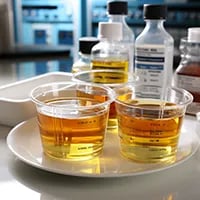Share this
5 common ways to test for drugs and alcohol
by Neoteryx Microsampling on Dec 28, 2020 9:00:00 AM
 To effectively address substance abuse in various settings, it's essential to understand common drug and alcohol testing methods. These methods help identify misuse and ensure safety in environments such as workplaces, healthcare facilities, and law enforcement..
To effectively address substance abuse in various settings, it's essential to understand common drug and alcohol testing methods. These methods help identify misuse and ensure safety in environments such as workplaces, healthcare facilities, and law enforcement..
Substance-abusing employees can detrimentally impact a company's productivity and bottom line. Data from the National Safety Council paints a stark picture:
- Drug-abusing employees are 2-5 times likelier to be tardy, absent, exhibit aggressive behavior, or suffer injuries at work.
- Workplace accidents due to drug abuse account for 50%, and drug-related theft constitutes 40%.
- A staggering 70% of the 14.8 million American drug users are part of the workforce.
- Among illegal drug consumers, 74% are employed and are responsible for 40% of industrial fatalities in the U.S.
Given these concerns, numerous corporate entities have introduced drug-testing protocols to identify and manage substance abuse among employees. The types of tests are shaped by various determinants, including regional and federal regulations and the specific substances being screened.
How Long Do Drugs and Alcohol Stay in the System?
The longevity of a drug's detectable presence in the human body varies considerably. For example, the euphoric effects of cocaine might last merely 15-30 minutes, but the drug can persist in a person's system much longer.
Similarly, LSD's psychoactive impact in the system lasts 6-12 hours. Alcohol's dynamics are more multifaceted: post-consumption, it can be identified in a person's breath and blood for nearly a day. Alcohol can be traced in urine for upwards of 80 hours.
The strategy for analyzing biological samples to screen for drugs and alcohol correlates to how long a substance remains in the system. While certain drugs fade rapidly, others linger for extended periods.
Factors influencing a drug's stay in the human body include:
- Dosage
- Consumption regularity
- Individual hydration
- Health conditions
- Metabolic efficiency
- Physical activity levels
- Specific drug type
Five Types of Drug Tests
The drug or alcohol tests performed by a toxicology lab or other laboratory may vary depending on the type of substance or drug being screened, and the types of samples needed for lab analysis. The most common drug test types include:
1. Breath Test
 Law enforcement officers often use the breath test technique to screen for alcohol consumption in drivers. The traffic control officers use a breathalyzer, which tests the exhaled breath and water vapor for blood plasma alcohol concentration. It’s a popular method because collecting the samples is non-invasive and convenient for roadside testing. Based on recent research, future roadside alcohol testing may include finger-prick blood collection, or microsampling, to detect PEth, an alcohol biomarker in the blood.
Law enforcement officers often use the breath test technique to screen for alcohol consumption in drivers. The traffic control officers use a breathalyzer, which tests the exhaled breath and water vapor for blood plasma alcohol concentration. It’s a popular method because collecting the samples is non-invasive and convenient for roadside testing. Based on recent research, future roadside alcohol testing may include finger-prick blood collection, or microsampling, to detect PEth, an alcohol biomarker in the blood.
2. Urine Test
 The urine test is the most common method used to detect illicit drugs. The "pee-in-a-cup" sample collection is non-invasive; it doesn’t involve the use of needles. Urine samples can contain high concentrations of parent drugs (drugs being tested for) and drug by-products.
The urine test is the most common method used to detect illicit drugs. The "pee-in-a-cup" sample collection is non-invasive; it doesn’t involve the use of needles. Urine samples can contain high concentrations of parent drugs (drugs being tested for) and drug by-products.
However, urine samples are less effective than some other methods at detecting drugs and alcohol because they have a short retrospective period. In other words, a urine test is less likely to detect regular drug use beyond a 48-window period. Another drawback of urine testing is the ease and opportunity for tampering with or switching out the samples.
3. Blood Test
While whole blood testing is more invasive than breath tests and urine tests, it’s the most effective at detecting specific alcohol concentration levels in a person's system. Certain blood tests show the precise levels of intoxication 24 hours after drinking.
 Because traditional needle blood draws are invasive, many labs now offer a less invasive blood sample collection method known as Volumetric Absorptive Microsampling technology (VAMS) with the portable Mitra® device which, facilitates a quick and less invasive method of collection compared to conventional blood sampling, And Unlike venipuncture, Mitra allows for remote blood collection from a finger-stick.
Because traditional needle blood draws are invasive, many labs now offer a less invasive blood sample collection method known as Volumetric Absorptive Microsampling technology (VAMS) with the portable Mitra® device which, facilitates a quick and less invasive method of collection compared to conventional blood sampling, And Unlike venipuncture, Mitra allows for remote blood collection from a finger-stick.
The microsamples from these devices can be analyzed in the lab following a typical dried blood spot (DBS) workflow. Blood can reveal more than just the presence of drugs. researchers have discovered that PEth, a direct biomarker of alcohol consumption, can be detected in blood microsamples. Bioanalysis of blood microsamples also shows drug metabolites in the blood, and the actual level of drugs in the blood.
4. Saliva Test
 Saliva testing is another minimally invasive drug testing method. However, saliva is only useful in testing for recent drug use. For example, saliva testing for marijuana can only provide accurate results if the subject has smoked or used cannabis within 4-10 hours.
Saliva testing is another minimally invasive drug testing method. However, saliva is only useful in testing for recent drug use. For example, saliva testing for marijuana can only provide accurate results if the subject has smoked or used cannabis within 4-10 hours.
5. Hair Test
 Drug metabolites enter the blood vessels in the scalp. The hair filters the drugs and keeps a permanent record of the drug use. This means a user who took cocaine, marijuana, or other drugs several months ago may still test positive for those drugs because the drug residues remain in the hair.
Drug metabolites enter the blood vessels in the scalp. The hair filters the drugs and keeps a permanent record of the drug use. This means a user who took cocaine, marijuana, or other drugs several months ago may still test positive for those drugs because the drug residues remain in the hair.
In summary, to maintain safety and compliance across different sectors, it's crucial to understand common drug and alcohol testing methods. Each method offers unique advantages and limitations, and selecting the appropriate test depends on the specific context and objectives.

Share this
- Microsampling (206)
- Research, Remote Research (119)
- Venipuncture Alternative (106)
- Clinical Trials, Clinical Research (83)
- Mitra® Device (73)
- Therapeutic Drug Monitoring, TDM (51)
- Dried Blood Spot, DBS (39)
- Biomonitoring, Health, Wellness (30)
- Infectious Disease, Vaccines, COVID-19 (24)
- Blood Microsampling, Serology (23)
- Omics, Multi-Omics (21)
- Decentralized Clinical Trial (DCT) (20)
- Specimen Collection (18)
- Toxicology, Doping, Drug/Alcohol Monitoring, PEth (17)
- Skin Microsampling, Microbiopsy (14)
- hemaPEN® Device (13)
- Preclinical Research, Animal Studies (12)
- Pharmaceuticals, Drug Development (9)
- Harpera Device (7)
- Industry News, Microsampling News (5)
- Antibodies, MAbs (3)
- Company Press Release, Product Press Release (3)
- Environmental Toxins, Exposures (1)
- July 2025 (1)
- May 2025 (1)
- April 2025 (2)
- December 2024 (2)
- November 2024 (1)
- October 2024 (3)
- September 2024 (1)
- June 2024 (1)
- May 2024 (1)
- April 2024 (4)
- March 2024 (1)
- February 2024 (2)
- January 2024 (4)
- December 2023 (3)
- November 2023 (3)
- October 2023 (3)
- September 2023 (3)
- July 2023 (3)
- June 2023 (2)
- April 2023 (2)
- March 2023 (2)
- February 2023 (2)
- January 2023 (3)
- December 2022 (2)
- November 2022 (3)
- October 2022 (4)
- September 2022 (3)
- August 2022 (5)
- July 2022 (2)
- June 2022 (2)
- May 2022 (4)
- April 2022 (3)
- March 2022 (3)
- February 2022 (4)
- January 2022 (5)
- December 2021 (3)
- November 2021 (5)
- October 2021 (3)
- September 2021 (3)
- August 2021 (4)
- July 2021 (4)
- June 2021 (4)
- May 2021 (4)
- April 2021 (3)
- March 2021 (5)
- February 2021 (4)
- January 2021 (4)
- December 2020 (3)
- November 2020 (5)
- October 2020 (4)
- September 2020 (3)
- August 2020 (3)
- July 2020 (6)
- June 2020 (4)
- May 2020 (4)
- April 2020 (3)
- March 2020 (6)
- February 2020 (3)
- January 2020 (4)
- December 2019 (5)
- November 2019 (4)
- October 2019 (2)
- September 2019 (4)
- August 2019 (4)
- July 2019 (3)
- June 2019 (7)
- May 2019 (6)
- April 2019 (5)
- March 2019 (6)
- February 2019 (5)
- January 2019 (8)
- December 2018 (3)
- November 2018 (4)
- October 2018 (7)
- September 2018 (6)
- August 2018 (5)
- July 2018 (8)
- June 2018 (6)
- May 2018 (5)
- April 2018 (6)
- March 2018 (4)
- February 2018 (6)
- January 2018 (4)
- December 2017 (2)
- November 2017 (3)
- October 2017 (2)
- September 2017 (4)
- August 2017 (2)
- July 2017 (4)
- June 2017 (5)
- May 2017 (6)
- April 2017 (6)
- March 2017 (5)
- February 2017 (4)
- January 2017 (1)
- July 2016 (3)
- May 2016 (1)
- April 2016 (2)



Comments (8)